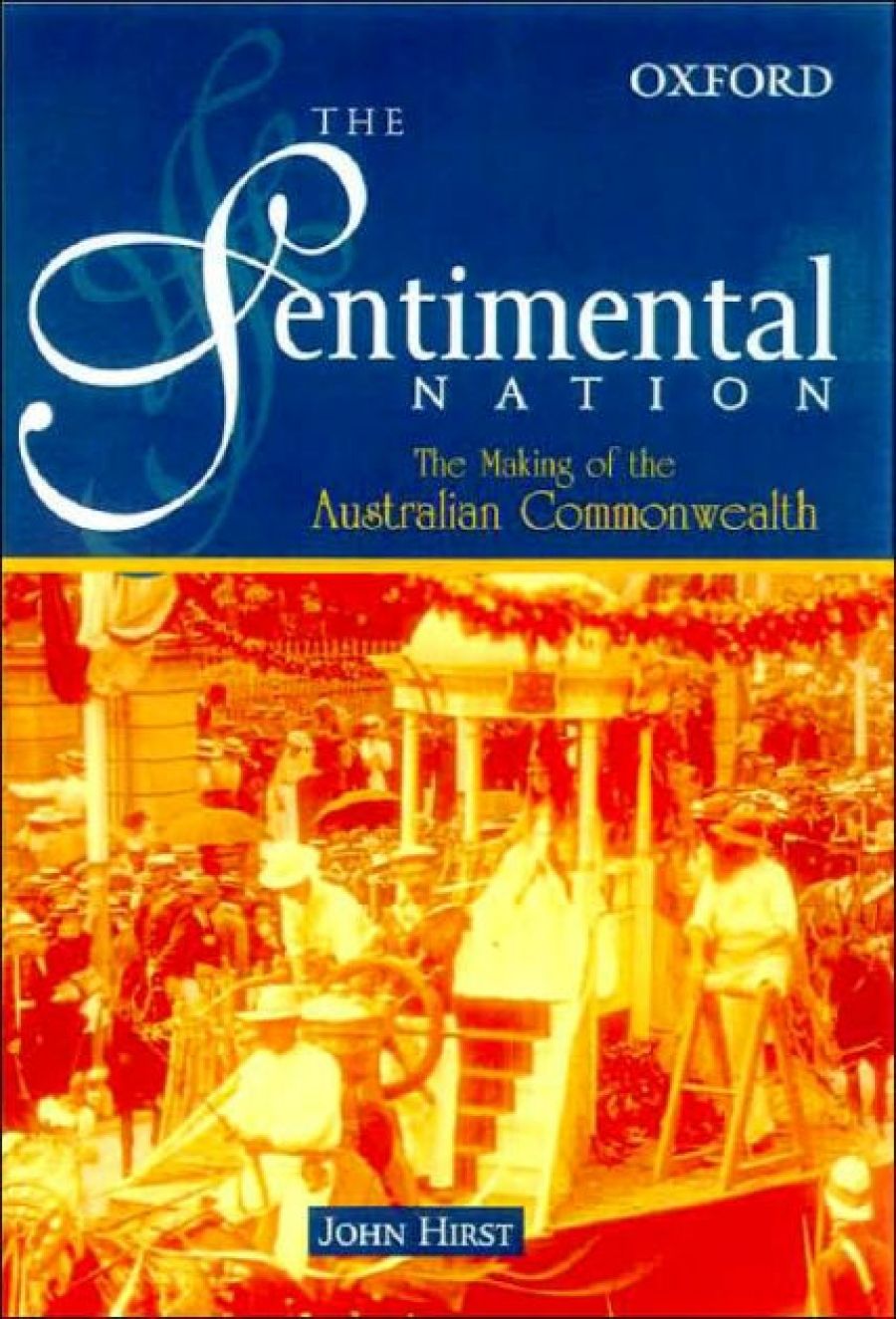
- Free Article: No
- Contents Category: History
- Review Article: Yes
- Online Only: No
- Custom Highlight Text:
When John Hirst accepted the challenge of writing a history of Federation of scholarly quality but fit for a broad popular readership, he may have felt himself on a hiding to nothing. Previous historians have succeeded in convincing Australians that the story of the making of the Australian Commonwealth is at best dull.
- Book 1 Title: The Sentimental Nation
- Book 1 Subtitle: The making of the Australian Commonwealth
- Book 1 Biblio: Oxford University Press, $34.95 hb, 388 pp, 0195506200
Like the direct-election republicans who combined with the ‘if-it-ain’t-broke-don’t-fix-it’ monarchists in a ‘No’ vote for the republican referendum of 1999, many Labor voters joined conservatives in opposing Federation in 1898–99. They thought it undemocratic that states with small populations should return the same number of senators as Victoria or New South Wales. In the event it was the smaller states – Queensland, South Australia, and Western Australia – that elected the Labor men who held the balance of power in the Senate in the first parliament, and thus secured the ALP a foothold for the future.
Despite the dismal showing of the early radicals as prophets, and despite the subsequent success of the ALP in using Commonwealth power for reform, the jeremiahs of the Labor movement have exercised an influence out of all proportion to their numbers over the thinking of later historians. L.F. Crisp, disappointed at the resistance of the states in the1940s to the Curtin and Chifley governments’ centralised reform agenda, saw the federal constitution as a botched confection rushed on the Australian public by over-enthusiastic partisans. Manning Clark thought Federation part of a great calm-down through which the propertied classes thwarted the republican radicalism of the 1890s and kept us tied to Mother England’s apron-strings.
The calm, sober scholarship of John La Nauze in the 1960s did little to rescue the Federation movement in the eyes of posterity. Crisp’s and Clark’s view of Federation as a neglected opportunity has coloured much recent thinking, particularly in the modern republican movement. To convince Australian voters that a change to a republic is essential, it has been necessary to stress the imperfections of our present arrangements, including the federal system.
Even before the official Centenary of Federation junketings, a counter-attack has been forming. At a number of conferences organised by Helen Irving and her colleagues on the1901 Committee, scholars have revealed that grassroots debate on Federation in the1890s was widespread and well informed. Whatever criticisms may be made of Barton, Deakin, and the other architects of Federation, they took care that the arguments were thoroughly understood by the voting public. Accordingly they won their ‘Yes’ votes where the republicans of 1999 failed.
Bob Birrell, in Federation: The secret history, went further. He argues that intellectuals steeped in the recent discourses of feminist, migrant, and Aboriginal history have downplayed the achievement of Federation because it promoted a civic ethos which excluded too many minorities. For Birrell, the civic ethos of the Federation era, with a ‘fair go’ reformism tending towards social democracy, was an admirable foundation for Australian national identity. Unfortunately, later generations failed to build on it adequately.
I think Birrell needs to answer Stuart Macintyre’s point that during at least the first half of the twentieth century a celebratory view of Federation dominated the history books, and yet failed to establish itself in the public imagination. Birrell also underplays the role of Crisp and Clark in questioning that orthodoxy. But much of Birrell’s argument finds powerful endorsement in John Hirst’s magisterial analysis.
Hirst has written a first-class – dare I use the word ‘definitive’? – account of the making of the Australian Commonwealth. He does not focus narrowly on the period between Parkes’s Tenterfield speech of October 1889 and the national celebrations of 1 January 1901. He looks at the shaping of a sense of national identity during the later nineteenth century and the practical barriers which impeded national togetherness in the same period. He also looks forward at the workings of federalism in the twentieth century and the rise of the republican movement of which he was a partisan.
Hirst refutes Crisp, Clark, and the other critics. Federation was not a conspiracy of businessmen aiming at the better organisation of Australian capitalism. The Australian colonies could have formed a customs union and employers’ organisations could have co-operated across the continent without Federation. The direct and indirect influence of business lobbies in shaping the federal constitution was less than might have been expected.
In Hirst’s view, it did not require Federation to secure uniform legislation against Chinese immigration or to co-ordinate the running of the railways and communications systems. This, he says, was already happening.
A Western Australian may be excused for wondering whether there would have been an east–west transcontinental railway without the backing of a federal Commonwealth. I also think Hirst underestimates the problems of negotiating a common defence policy without a national taxation system. But he certainly makes his point that Federation was not inevitable in 1901.
The essential factor was national sentiment. Most of Australia’s inhabitants thought of themselves not as second-hand English, nor as just Victorians, Queenslanders, or Tasmanians, but as Australians. This sense of themselves as Australians moved the 422,788 voters who said ‘Yes’ and who, in the words of Hirst’s dedication, have no other memorial.
That is an arresting statistic. Some have defined Australian nationhood as created by the 420,000 men who enlisted for the 1914–18 war. Here is an equal number drawn from a somewhat smaller population, including South and Western Australian women and probably a few Aborigines, using the democratic process in 1898–1900 to constitute a nation. As Professor Anthony Low has observed, Australia is the first nation in the world created at the ballot box. John Hirst gives us reason to celebrate that achievement.


Comments powered by CComment